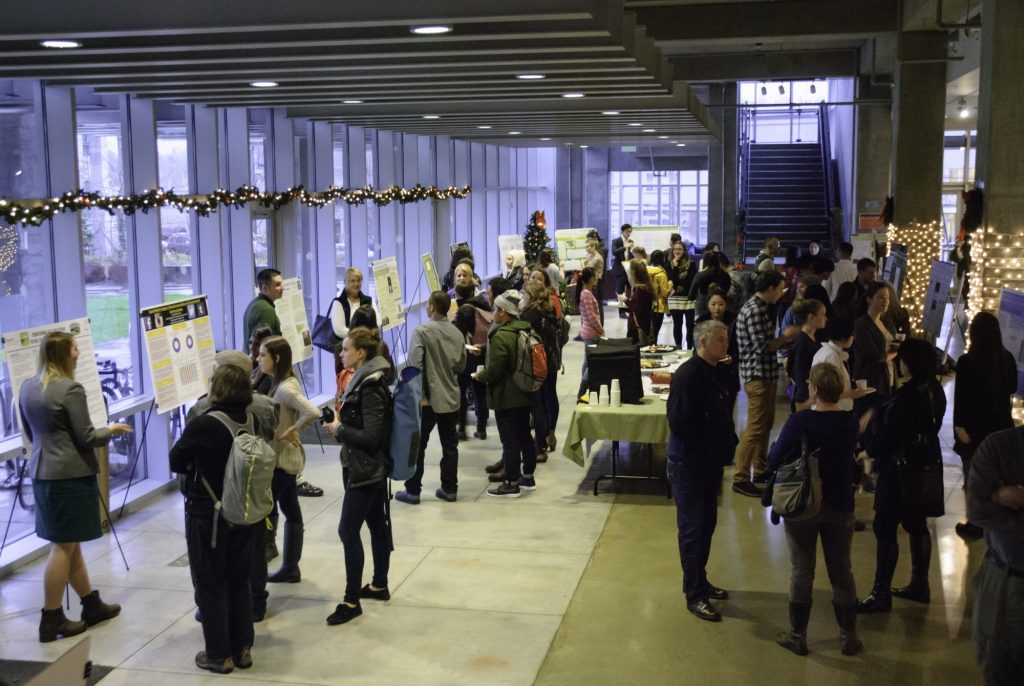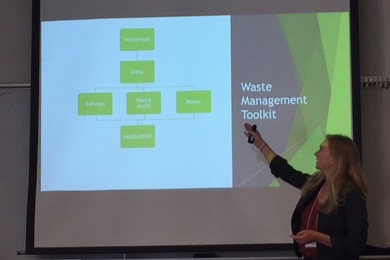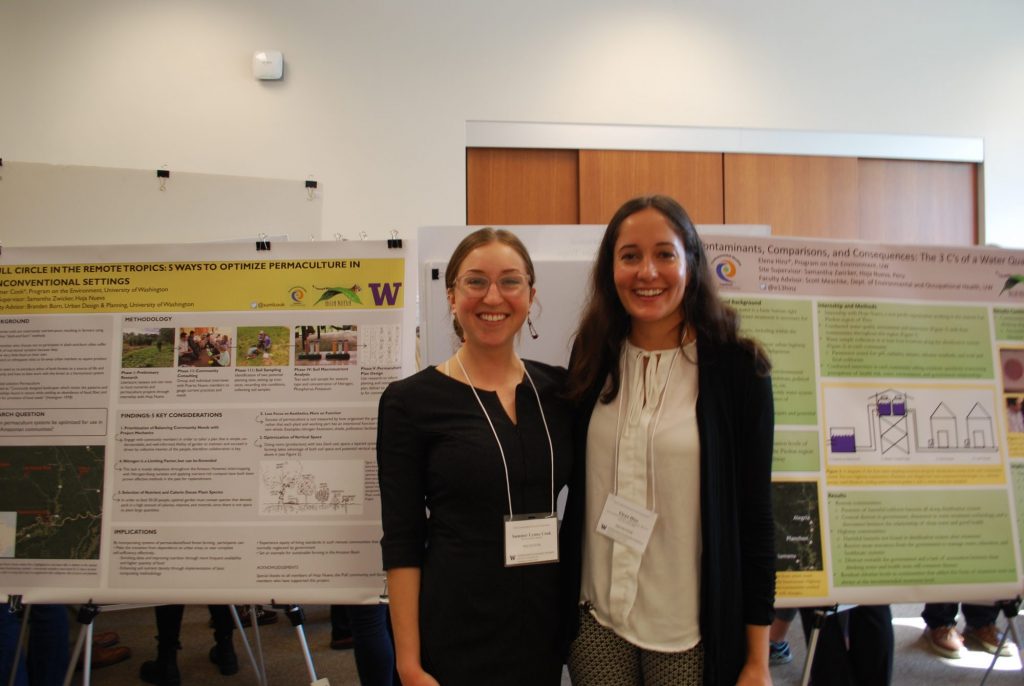The Program on the Environment will host the Autumn 2022 Capstone Symposium on Wednesday, November 30, online AND on Wednesday, December 7, in person at the UW School of Aquatic Fisheries & Science. All are welcome to attend and support students as they present on the culmination of their hard work over three quarters.
The Capstone Course Series is a highlight for many students, and serves to catapult some into their first jobs or even their dream careers. Through internships, research, and social media training, students come out of the experience well equipped to communicate about the problem they sought to solve, and to tie their academic learning with specific research questions.
This event is open to the public, and we encourage students interested in learning about the Capstone, as well as members of the community, to join us. Please also follow the event on Twitter #POEcap.
Learn More:
- Autumn 2022 Symposium Program
- Compiled abstracts with additional information about each project.
Autumn 2022 Symposium Schedule
DAY 1: Online Poster Symposium (Wednesday, November 30)
4:30 PM – 4:40 PM Welcome & Session Overview
4:40 PM – 4:50 PM Session A Speaker Intros
4:50 PM – 5:50 PM Poster Session A – Agriculture & Food Systems; Business & Sustainability; Natural Science & Restoration
Hibaaq Arte (Room #1): Tree Health In a Warming Climate: A Synthesis of the Western Redcedar Case Study. Site Partner: WSU and Forest Health Watch (Poster PDF) (Video)
Brendan Baudette (Room #2): Crab Battles: Comparison of the Early Life History of Dungeness Crabs to Yellow Shore Crabs. Site Partner: UW and Pacific Northwest Crab Research Group (Poster PDF) (Video)
Yeandya Teklu (Room #3): Can Trawling Gear Be Modified to Catch Fish More Efficiently? Site Partner: NOAA (Poster PDF) (Video)
Ally Galiotto (Room #4): Identifying Trends in Dungeness Crab Larval Abundance Across Puget Sound. Site Partner: UW and Pacific Northwest Crab Research Group (Poster PDF) (Video)
Kaylee Kobashigawa (Room #5): How Grassroots Sustainability Initiatives Can Be Facilitated in the Corporate Sector. Site Partner: Seattle Public Utilities (Poster PDF) (Video)
Tore Landboe (Room #6): Aquacide: Diquat Bromide and Its Effects on Portage Bay Wildlife. Site Partner: Agua Verde Paddle Club, Inc (Poster PDF) (Video)
Jeremy Leung (Room #7): Salmon Habitat Monitoring Efforts and Areas for Improvement. Site Partner: Stillwaters Environmental Center (Poster PDF) (Video)
David Lin (Room #8): Return to Equilibrium: Monitoring the Recovery of a Salt Marsh in Kingston, WA. Site Partner: Stillwaters Environmental Center (Poster PDF) (Video)
Michael Qiu (Room #9): Candidates for Future Sustainable Transportation. Site Partner: Seattle Subway Foundation (Poster PDF) (Video)
Ashley Rosales (Room #10): Lumber Mills and Certifications: Who Knew It Would Be This Hard? Site Partner: Northwest Natural Resource Group (Poster PDF) (Video)
Ryland Schaul (Room #11): Douglas Fir Mortality: Monitoring Douglas Firs in Seward Park. Site Partner: Friends of Seward Park (Poster PDF) (Video)
Taylor Welch (Room #12): Weekly Observation of Tide Data and Wind Conditions of Dungeness Crab Megalopae. Site Partner: UW and Pacific Northwest Crab Research Group (Poster PDF) (Video)
Hannah Whobrey (Room #13): Aiding the Bandaid: How Do We Improve Food Charity? Site Partner: City Fruit (Poster PDF) (Video)
5:50 PM – 6:00 PM BREAK
6:00 PM – 6:05 PM Session B Overview
6:05 PM – 6:15 PM Session B Speaker Intros
6:15 PM – 7:15 PM Poster Session B – Arts & Humanities, Education & Outreach, Policy & Regulation
Autumn Aho (Room #1): How Art Helps Kids Process Environmental Knowledge. Site Partner: Chrysalis Forest School (Poster PDF) (Video)
Camille Andrew (Room #2): Climate Anxiety and Its Relationship with Environmental Education and Activism. Site Partner: UW Bothell and Cascadia College (Poster PDF) (Video)
Eva Maria Burns (Room #3): Trees? Yes, Please: Forest Schools & the Development of Social and Environmental Interactions. Site Partner: Fiddleheads Forest School (Poster PDF) (Video)
Alyson Cline (Room #4): The Limitations of Residential Sustainable Landscaping and How to Overcome Them. Site Partner: HomeGrown Organics (Poster PDF) (Video)
Mikaela Ebbeson (Room #5): Encouraging Beachgoers to Keep Wildlife Wild: Pinniped Science Communication. Site Partner: NOAA (Poster PDF) (Video)
McKenna Eggers (Room #6): How Communication Differences Impact the Effectiveness of Environmental Organizations. Site Partner: King County (Poster PDF) (Video)
Rachel Glessner (Room #7): Bridging the Gap: Using Complex Documents for General Environmental Communication. Site Partner: Seattle Subway Foundation (Poster PDF) (Video)
Anneliese Hasenbalg (Room #8): The Rule of Law: Equitable Environmental Policy in the United States. Site Partner: NOAA (Poster PDF) (Video)
Ben Hauge (Room #9): Environmental Moral Dilemmas: Understanding and Living with Moral Uncertainty About Climate Change and Beyond. Site Partner: UW Bothell and Cascadia College (Poster PDF) (Video)
Kailuhia Lam (Room #10): Supporting Environmental Justice Through Screening and Mapping Tools. Site Partner: NOAA (Poster PDF) (Video)
Taylor Magee (Room #11): Expanding Solar Power: How Identifying Barriers Can Foster New Growth for Green Energy in King County. Site Partner: King County (Poster PDF) (Video)
Ava Merkley (Room #12 ): Linking Seattle’s Youth: The Quest to Increase Youth Light Rail Ridership. Site Partner: Seattle Subway Foundation (Poster PDF) (Video)
Paige Milham (Room #13): How to Crush Climate Change Communication. Site Partner: King County (Poster PDF) (Video)
Mackenzie Rippel (Room #14): What Does It Take for a Workforce Development Program to Be Successful? Site Partner: 2050 Project (Poster PDF) (Video)
Isla Scott (Room #15): Tackling Multifaceted Environmental Justice Issues: The Importance of Community Engagement and How to Create It. Site Partner: Defenders of North SeaTac Park (Poster PDF) (Video)
Madelyn Ulvin (Room #16): Four Outreach Components to Garner Participation in Environmental Stewardship Programs. Site Partner: City of Burien (Poster PDF) (Video)
7:15 PM – 7:30 PM Closing
DAY 2: Oral Presentation Symposium & Celebration (Wednesday, December 7)
UW School of Aquatic Fishery & Sciences | 1122 NE Boat St, Seattle, WA 98105
5:00 PM – 5:10 PM Welcome & Housekeeping (Lobby)
5:10 PM – 5:40 PM Poster Highlights** & Refreshments
5:40 PM – 5:50 PM BREAK
5:50 PM – 5:55 PM Session Introduction (FSH 102)
5:55 PM Kelsey Price: Salmon, Culverts, and Court: What Happened and What to Expect. Site Partner: Coast Salmon Partnership (Video)
6:05 PM Mason Wrenn: Sustainable Communication: Initial Engagement Methods and Maintenance of Hope. Site Partner: NOAA (Video)
6:15 PM Ozi Goldstein: Gleaning in Public Consciousness: How Gleaning Has Changed and It’s Potential to Advance Food Justice. Site Partner: City Fruit (Video)
6:25 PM Pedro Fernandez: Forest Health: Compounding Disturbances & the Advancements of Management Technology. Site Partner: WA Department of Natural Resources (Video)
6:35 PM Matthew Dollinger: Early Fish Gets the Worm: Examining Differences in Spawning Timing between Male and Female Hatchery and Wild Chum Salmon. Site Partner: Sitka Sound Science Center (Video)
6:45 PM Danica Yeh: Pitching the Switch to Reuse: How to Overcome the Barriers to Corporate Sustainability. Site Partner: Cascadia Consulting Group (Video)
7:25 PM – 7:30 PM Symposium ends & celebration continues in Lobby/Lawn
**Note: the Judges will choose 10 posters from Day 1, which will be printed out and displayed during Day 2. Those poster authors will be invited to present their posters during the reception.


